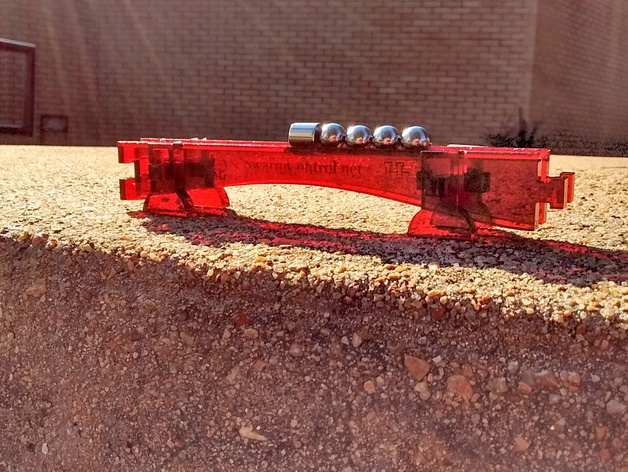
Gauss Gun (magnetic accelerator)
thingiverse
Laser-cut design components for a Newton's cradle/Gauss gun are available. Assembling instructions can be found at https://youtu.be/IWAIx6-hRZI. For an overview of Gauss guns and a video of them shattering 3 glass light bulbs, see https://youtu.be/nWyTd7dF0ys. This project is designed to help young students learn about energy and its role in creating motion. Energy cannot be created or destroyed; it can only be transferred between objects and from one form to another. The Newton's cradle and the Gauss gun demonstrate how gravity and magnetism (potential energy) help things move (kinetic energy), and how energy, thus motion, is transferred between objects when they come into contact. Designed by ECE undergraduate Javier Garcia, advised by Aaron T. Becker at the University of Houston. Overview and Background The purpose of this project is to demonstrate several forms of energy transfer. The model has two configurations, which are achieved by simply rotating the leg supports. When the curved faces are pointing up, the model is in the Newton’s cradle configuration, demonstrating the transfer of gravitational potential to kinetic energy. Some balls are placed on the valley and another is placed on one of the higher sides; as the ball rolls down towards the valley, it gains speed due to gravity, and when it hits the balls resting its momentum is transferred to the last ball on the opposite side, making it move. When the channels are pointing up, the model is in the Gauss gun configuration. In this case, a magnet is placed midway along the channel, and several balls are attached to only one side of it. Another ball is placed on the side of the gun where there’s nothing attached to the magnet and it’s given a little push. As the ball approaches the magnet, its speed is greatly increased since it’s made out of magnetic material, and as a result when the ball hits the magnet, the last ball on the opposite side is sent flying. Objectives After this project, students will have a better understanding of the concept of energy and one of the ways it affects objects (motion). They will also better understand how energy is transferred between objects, and transformed from potential to kinetic energy in this case. Lesson Plan and Activity Activity 1: Newton's Cradle Tell the students to put on their safety glasses and assemble the model in the Newton's cradle configuration. Distribute the balls and have the students discuss for a couple of minutes how they think gravity works. Afterwards, have them place some balls in the valley of the cradle and let a ball roll down from one of the sides again. When the moving ball hits the resting balls, the last ball on the opposite side will start moving; discuss that the kinetic energy from the ball rolling down is transferred all the way to the ball on the opposite side when it collides. At this point, you can also mention that the second ball in motion doesn't reach the top of the cradle, and that all the balls come to a rest after a while. Ask the students why they think this is the case. Discuss that energy must be leaving the system due to mechanisms such as friction. Mention that friction transforms kinetic energy into thermal energy, or heat. Ask students if they can think of other examples that demonstrates such transformation. Activity 2: Gauss Gun Tell the students to put on their safety glasses and assemble the model in the Gauss gun configuration. Distribute the magnets and have the students discuss for a couple of minutes how they think magnets work. Afterwards, have them place the magnet in the slot in the middle of the gun channel and to put 3-4 balls on one side of it. Tell them to make sure that the balls are aligned and centered, and that no one is right in front of the side of the gun where the balls are. Once that's done, they have to hold another ball on the opposite side of the channel, away from the magnet. Tell the students to pay close attention to what happens when the ball is given a little push towards the magnet. After shooting the gun a couple of times, ask them why the ball on the opposite side gains so much more speed compared to the Newton's cradle. Discuss that magnets, just like gravity, give objects the potential to move. Such form of energy is called potential energy, because it's stored in objects and it's transformed into kinetic energy when the objects are released. Also discuss that the magnetic potential in this case is greater than the gravity potential, giving the ball much greater speed as it approaches the resting balls, which explains why the ball all the way in the opposite side gets so much more kinetic energy transferred to it. If there's time, show the students how to connect multiple Gauss gun stages. The balls will shoot farther; discuss that multiple stages give the balls more speed which equals more kinetic energy. Materials Needed Bill of materials for 12 Gauss Gun V2 sets. Build instructions for Gauss Gun V2
With this file you will be able to print Gauss Gun (magnetic accelerator) with your 3D printer. Click on the button and save the file on your computer to work, edit or customize your design. You can also find more 3D designs for printers on Gauss Gun (magnetic accelerator).
